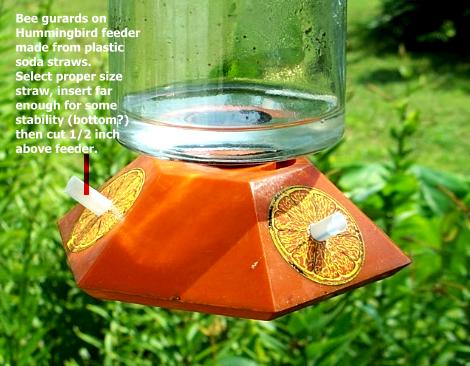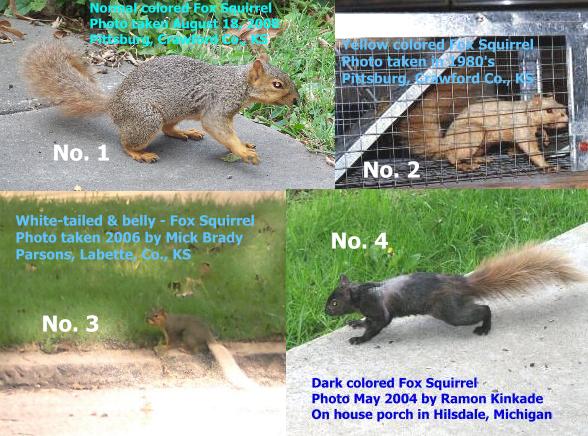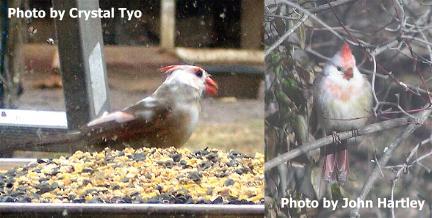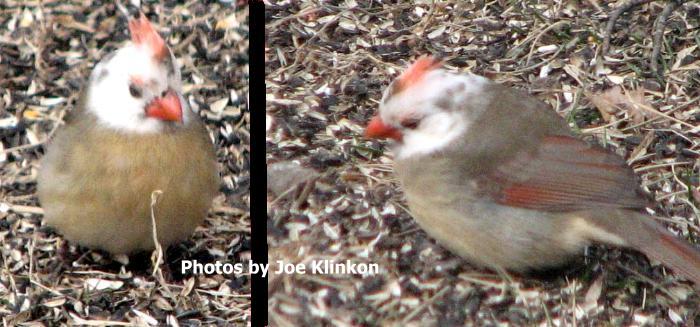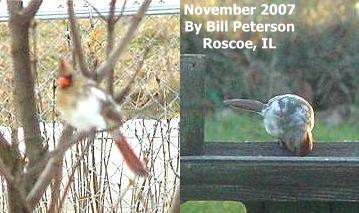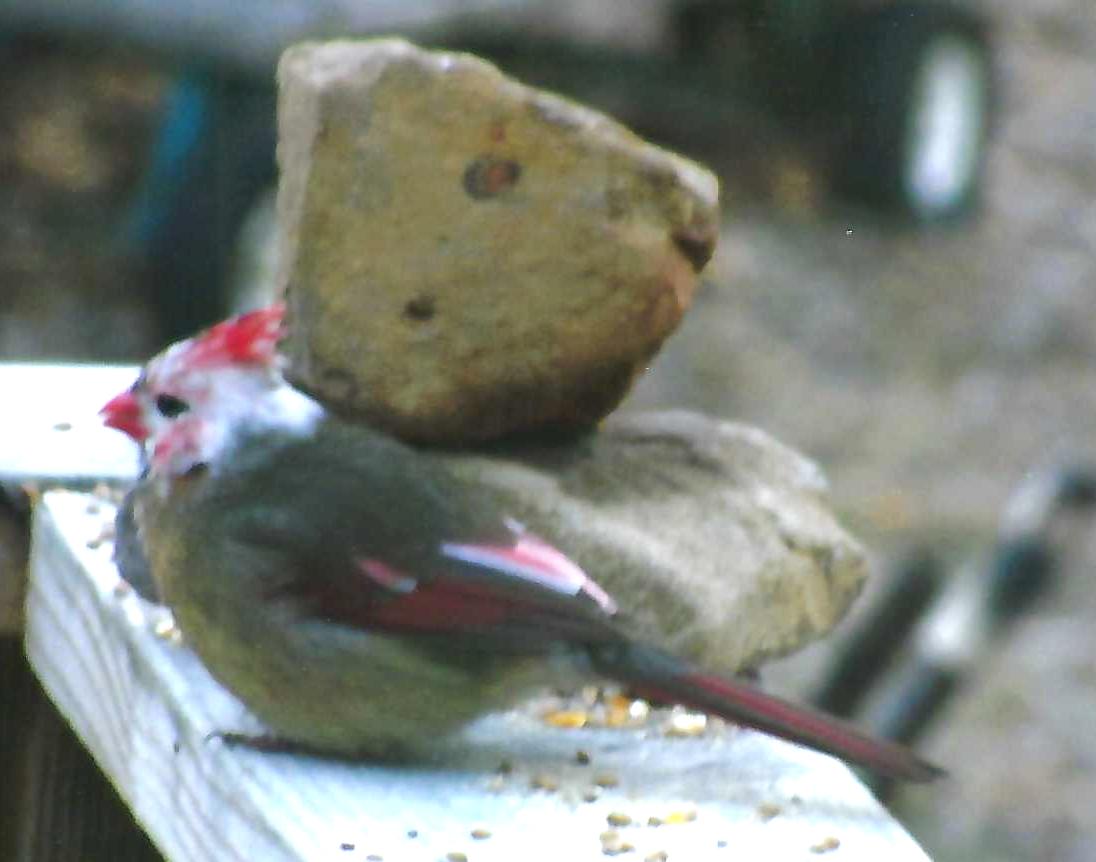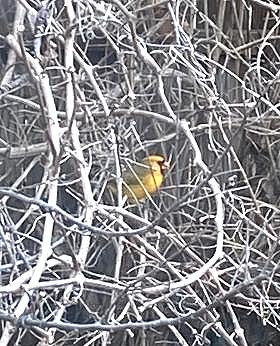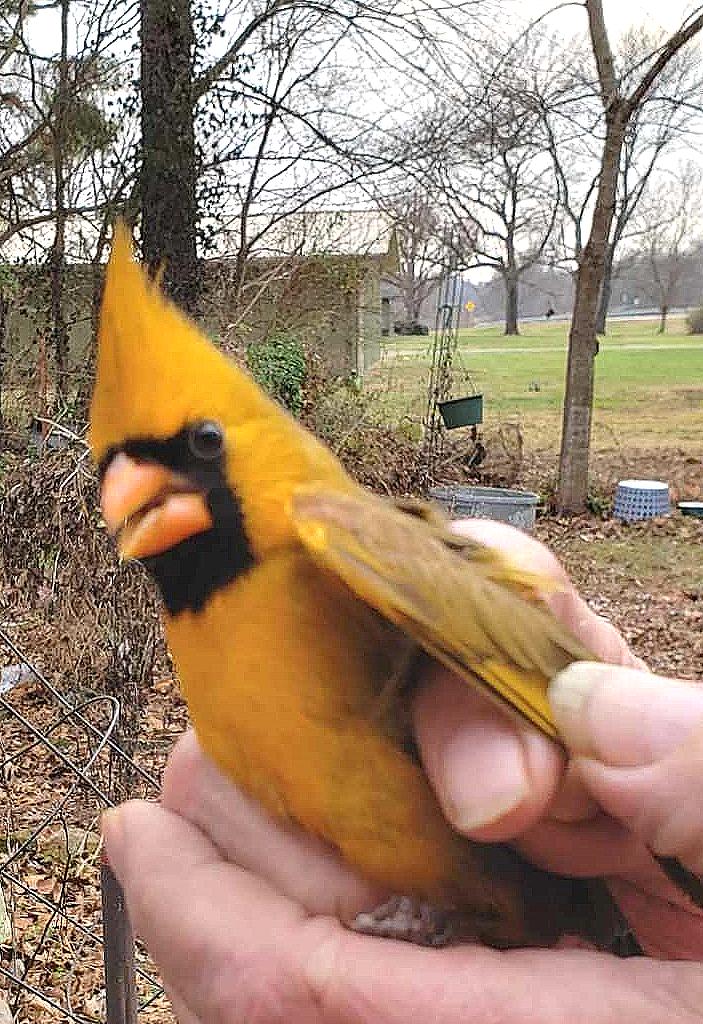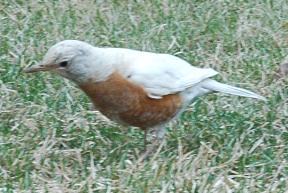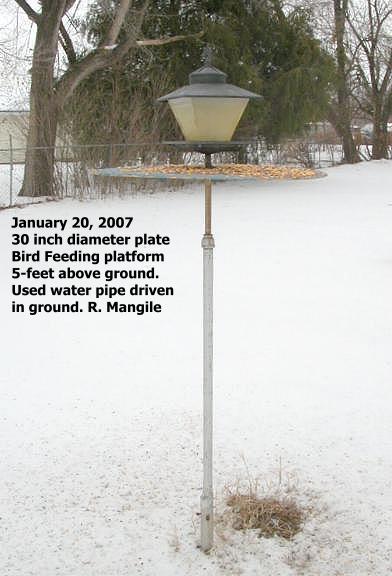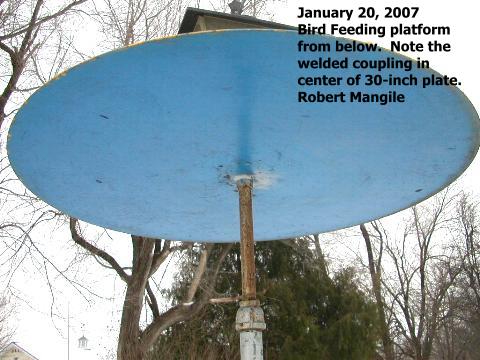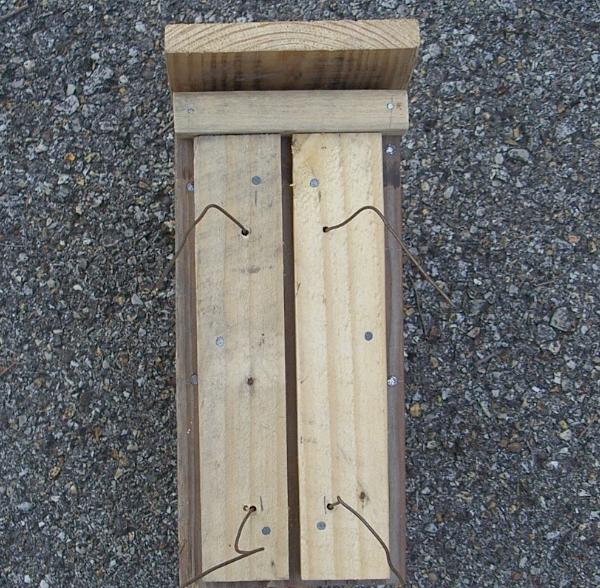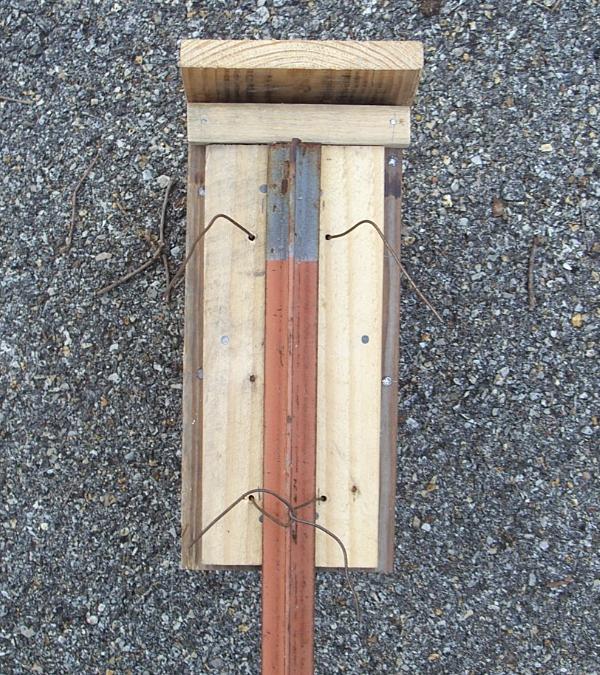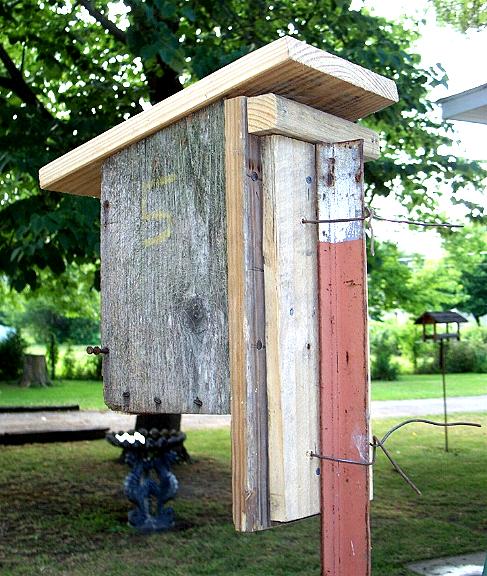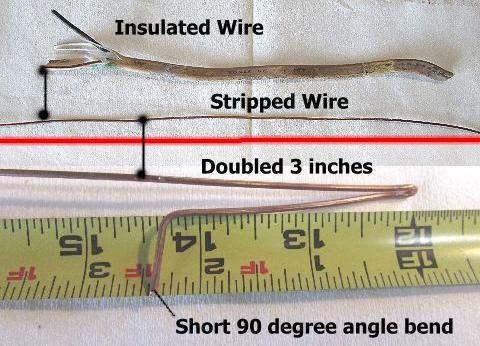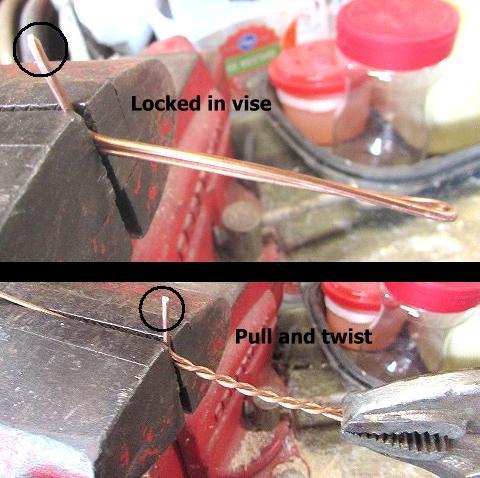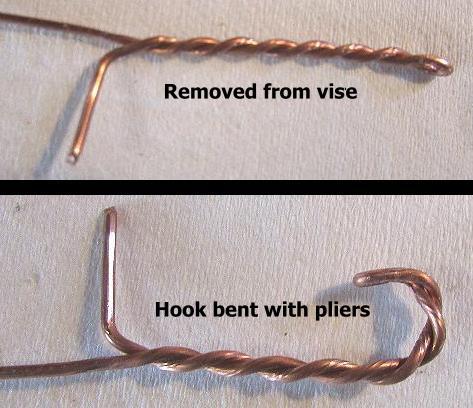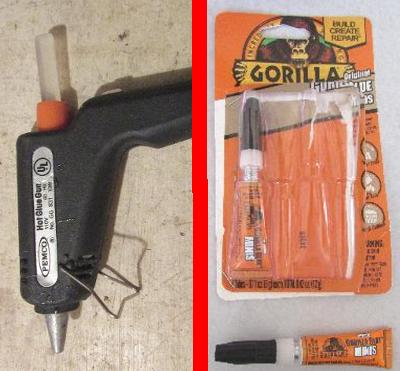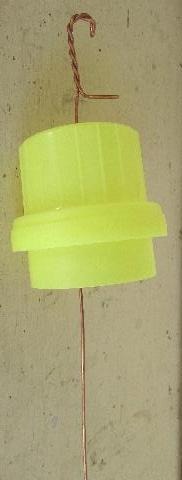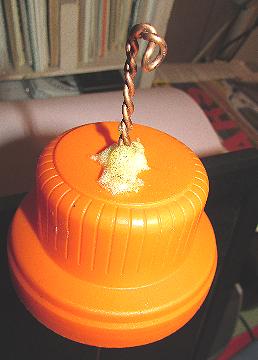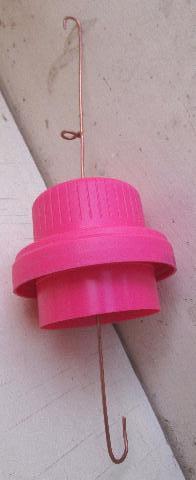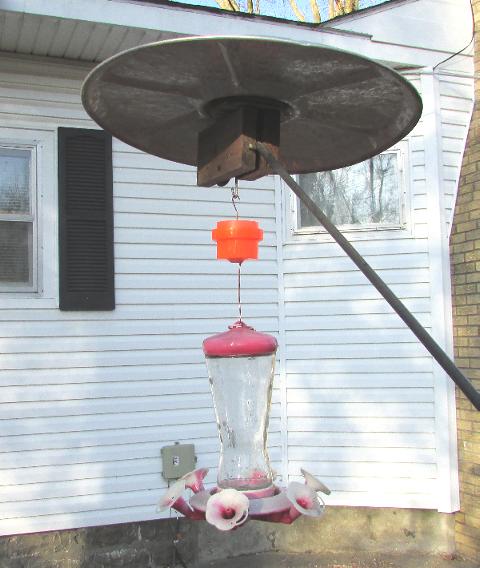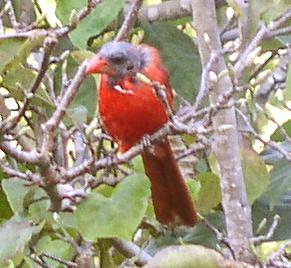
Black-headed
male Cardinal
Summer reports of birds displaying bare heads are not
too
uncommon. Most often the bird is a Cardinal, usually referred to
as red-birds by the general public. On July 27, 2005, the adult
male Cardinal in the photo (left) was photographed by Ron Ginardi of
Frontenac, KS, during one of its visits to his yard.
Ginardi thought he could see a "thin, lone feather was coming out of
the top of it's head". For an interesting account of this
condition in birds click here.
White
House Sparrow
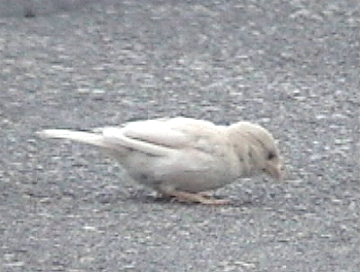
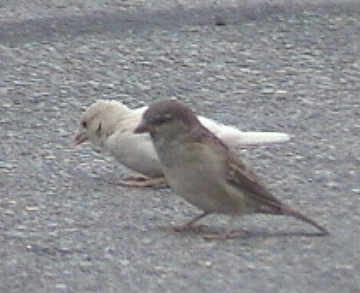
On August
29, 2003,
Jim
Ziebol photographed this very white "mutant" House Sparrow on a parking
lot near Tower Grove Park in the St. Louis, Missouri area. It was among
a small flock of House Sparrows and probably the same bird reported
earlier by Gail Ahumada. Thanks to Yvonne Homeyer for relaying Jim's
photos for use on this web page.
Please notice that the white bird has some dark (pigmented) areas in
its plumage and has, what appears to be, "dark eyes". Albinos are all
white with pink eyes.
(Photos by Jim Ziebol)
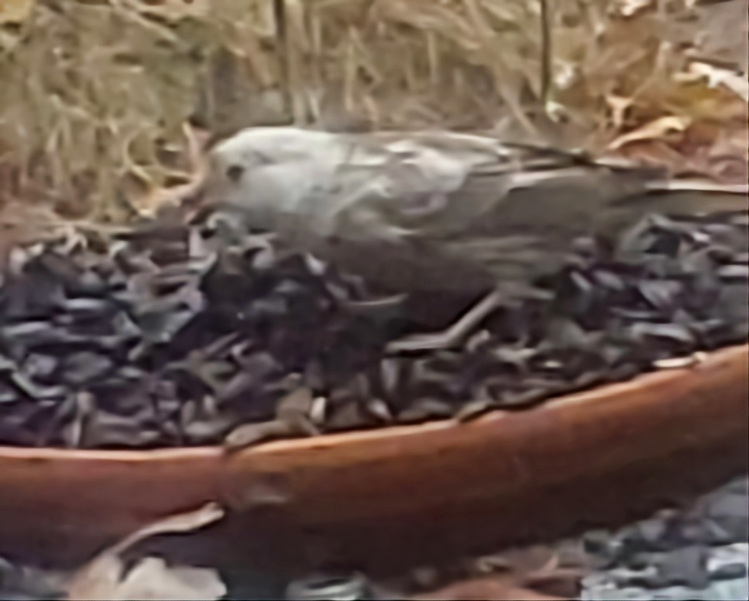
A leucistic House Finch with a white head.
Pied
House Finch female(?) with mostly white head photographed while
visiting the bird feeder at the Tom Glick residence in southwest
Pittsburg, Crawford County, Kansas in December 2024. This is likely the
resuls to a genetic condition call leucisim that reduced pigmentation
that often display some patches of white in the plumage.
Devoted Killdeer protecting nest.
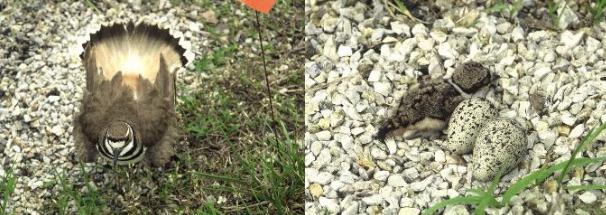
An orange flag marks a Killdeer nest on the
parking lot of Big Brutus,
just southwest of West Mineral, Cherokee County, Kansas. Emmett
Sullivan took these photos of this protective parent bird at very close
range, as it performed the "crippled wing" act. The nesting area
was protected from vehicles, allowing the Killdeer to nest
successfully. Killdeer nest in slight depressions in the rocks,
and as depicted in the adjacent photo the eggs are quite difficult to
see against the rocky background. The young are able to run soon
after hatching.
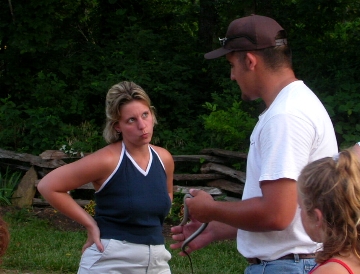 What is wrong with these
pictures?
What is wrong with these
pictures?
There is no doubt what is being projected by the body
language
of this young Mom! "I'm just fine but don't move one inch
closer!" The photo was taken on July 5, 2003, by my wife, Liz
Mangile, during a presentation on reptiles at Lake Crawford, near
Farlington, KS. Over 60 people, including many children, were in
attendance. Park Naturalist, Adam Murray, who assisted with the
presentation, tried to ease the tension as he attempted to get
this young Mom acquainted with a beautiful, harmless,
rough green snake. The kids begged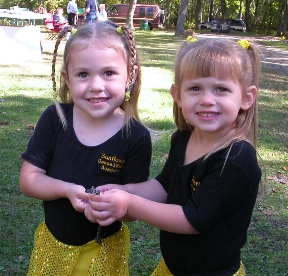 to hold the snake - but
adults are apparently much smarter! Other
adults responded in the same manner as the pretty young Mom in
the
photo - snakes represent a menace, to the adult mind. This photo
seems to be one
of those special shots that captures the essence of the moment; like
the
sailor kissing the girl on the street, after World War II . It is
too good a shot not to share.
to hold the snake - but
adults are apparently much smarter! Other
adults responded in the same manner as the pretty young Mom in
the
photo - snakes represent a menace, to the adult mind. This photo
seems to be one
of those special shots that captures the essence of the moment; like
the
sailor kissing the girl on the street, after World War II . It is
too good a shot not to share.
In stark contrast to the lady above, these two little cuties at the
right were completely unafraid of the baby black rat snake they were
holding. Their names are not known but they were fully aware of
their snake-bearing status - working the crowd as
ambassadors. They were part of a crowd pleasing baton show at the
October 4, 2003, Craft Show that was held as a fund raiser for the South East Kansas Nature Center
currently under construction in Schermerhorn Park at Galena, KS.
They deserve thanks for posing for the photo but as you might detect
the pleasure was all theirs! I wonder if Moms, like the one
above, can answer why their child's behavior is so much different than
their own. After all that is a "snake" they are holding!
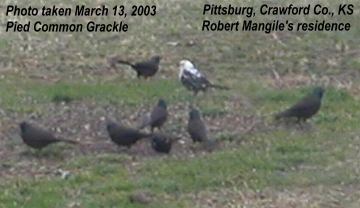
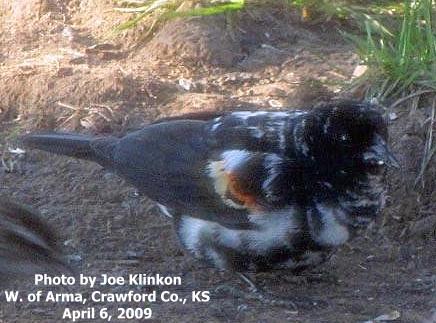
Pied
Common Grackle & Red-winged Blackbird
Throughout
the winter of 2002 and 2003
there were several reports of pied (spotted; partly colored)
"blackbirds"
in the Pittsburg, Crawford County, Kansas area. One such report
was of a solid white bird seen in a flock of blackbirds of unknown
species. On March 13, 2003, a pied common grackle Quiscalus
quiscula, (above left), visited our yard and was
photographed through
the window of our garage, as it mingled with a small flock of
other grackles. On April 6, 2009, Joe Klinkon snapped this pied
Red-winged Blackbird Agelaius phoeniceus, (above
right), that had been visiting a feeder at a friend's residence.
Such irregularly pied birds are erroneously
referred to as "partial albinos" and are
a human curiosity. Albinos are all white with pink eyes.
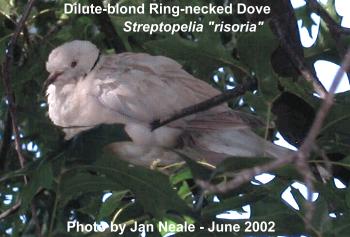
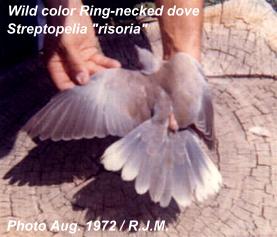
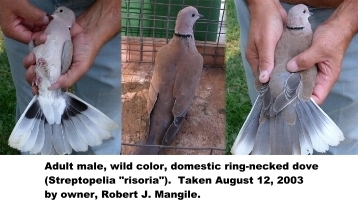
Dilute-blond
vs. Wild Color Ring-necked dove
 Click here
for call of Ring-necked Dove, Streptopelia "risoria"
Click here
for call of Ring-necked Dove, Streptopelia "risoria"
Upper
left: Photo of an apparent escaped domesticated
Ring-necked dove, Streptopelia "risoria" (call ringed
turtle
dove in birding guide books), was sent to me by Jan Neale of El
Dorado, MO. Upper right & Lower
left: The wildtype
coloration of the ring-necked dove
raised in captivity. - - Ring-necked doves have been bred in captivity
for centuries.
Escapees cause confusion among bird watchers
because they look much like the Eurasian Collard dove, Streptopelia
decaocto.
One of the most distinguishing characteristics
is the difference in their call. Domestic Ring-necked doves are
commonly bred in a variety of colors. The wild Eurasian Collard
dove is a bit larger and not found in a wide variety of colors.
The photo in upper left appears to be dilute-blond (or fawn
color). To learn more about the variety of
plumage
types in the domestic dove click here.
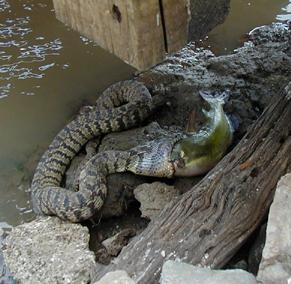
Diamondback Water Snake Eating Bullhead Catfish.
Caught in the act of eating one
of his
hand fed Bullhead Catfish, Bob Hurt of rural Pittsburg, KS snapped this
photo on August 15, 2002. The Diamondback Water Snake was said to
be about 3-feet, or so, in length and about 2-inches in diameter; the
catfish
was about 10-12 inches long. It took the resident snake, AKA
"Sneaky
Snake", about an hour to get itself around the catfish.
Great
shot Bob, and thanks for feeding the wildlife!
Addendum:
The diamondback water snake is not poisonous. Some species of
water snakes are called "water moccasins" but they should not be
confused with the Cottonmouth (Water) Moccasin, which is
poisonous. For a picture and some information about the
cottonmouth click here.
Squirrel
Proof Platform Feeder.
This is a Squirrel proof platform feeder that will end your
problems
with squirrels raiding your bird feeders. Just be sure it is
installed some distance from tree limbs that squirrels can use to jump
to the feeder. We have had two of them for over 30 years and
never observed a squirrel on them. The platform must not be made
of wood because the squirrels can get a grip on the edge of the
platform. Good luck.
How
to solidly
mount
a Bluebird Nest Box on Steel Post.
Mounting a nesting box on a steel post poses a problem.
Below is
a way to make a solid mount with very little effort. The wavered
lugs on one side of the post should fit into the approximately 1/4 to
3/8 inch gape between the Adapter Boards that are centered and nailed
on the back of the nest box. Then a Stop Block is needed at the
top to prevent the box from sliding down the post if the wires loosen
with time. The Stop Block should be thicker than the Adapter
Boards if applied directly to the back of the box - as shown in the photo below. . It might be best applied on top of
and across the top end of the
Adapter Boards. Be sure to flatted
the wire against the inside back of the box to prevent birds from
getting entangled. With pliers or vise grips twist the wire tight
against the post and bend ends inward to prevent injury. Be sure
to use a 6 foot post if possible so the box will be sufficiently high
enough off the ground. Also, consider the direction of the front
of the box before you drive the
post in the ground.
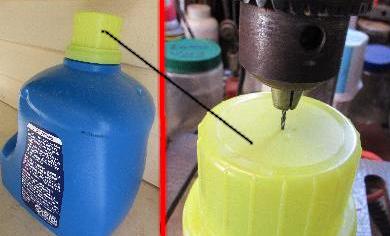 Cheap, easy
to make Ant Moat for Hummingbird sugar feeder.
Cheap, easy
to make Ant Moat for Hummingbird sugar feeder.
(Refer to photos to follow these procedures.) Thoroughly wash and drill
hole in center of lid from liquid washing soap for a tight fit for wire
being used. Any
pliable wire strong enough to support the weight of feed will work, I
use copper because it does not rust. Strip 10-12 inch piece of
wire and bend one end double about 3-inches, then make a short 90
degree bend on short end, as shown. (For
quicker alternate wire type twist a loop in wire as shown in pink
lid.) Put in vise as shown and
twist and "pull" doubled end with vise-grips. Remove from vise
and bend a hook on twisted end. Push long end of wire in drilled
hole in top of lid. Apply Gorilla Glue or Glue Gun glue under and
around wire and tab as shown - might need a second layer. Allow
to
dry for 24 hours. Bend hanging hook to personal needs.
Install moat and fill with water then hang feeder. After making
various versions this one seems the simplest one. Good luck.
 Maintained by:Robert J.
Mangile
Maintained by:Robert J.
Mangile
